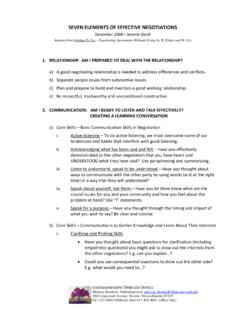Transcription of Negotiation Conflict Styles - Harvard Medical School
1 Information provided by: Ombuds Office, HMS/HSDM/HSPH 164 Longwood Avenue, Boston, MA 02115 Negotiation Conflict Styles by Calum Coburn Our style of Negotiation or profile can define whether we grind into a deadlock, or create value and an enduring relationship. So what do you do when your needs are incompatible and your path to agreement starts to fade? Negotiation Styles Understanding the Five Negotiation Styles People often ask "which is the best Negotiation style?" As with much management theory there is no single 'best' or 'right' approach. All five profiles of dealing with Conflict are useful in different situations. Although we're capable of using all five, most of us tend to have one or two preferred Negotiation Conflict Styles that we use unconsciously in most Conflict situations. Why? Either because our preferred Styles have worked for us in the past, or because of our temperament (nature) or because of our upbringing (nurture).
2 So if you're involved in business negotiations , which Negotiation Styles are likely to reward you with the biggest profit prizes? This question will be answered later in this article. First lets visit each of these important Conflict profile Styles . Conflict Model Typical Behaviours Compete (I win - You lose) Competitive style negotiators pursue their own needs - yes, even when this means others suffer. They usually don't want to cause others to suffer and lose, they are just so narrowly focused on their shorter term gains that they plunder obliviously through negotiations like a pirate. They often use whatever power and tactics they can muster, including their personality, position, economic threats, brand strength or size or market share. At its extreme negotiators call their behaviour aggressive or psychotic. When to use? When you need to act or get results quickly. Competition is critical when you are certain that something is not negotiable and immediate compliance is required.
3 Competition can be an effective defense or counter balance to use against negotiators with a competitive Conflict profile. We would recommend that you use a blended approach though, as both Negotiation parties locking horns in a competitive battle can result in a spiraling deadlock. When you're buying or selling something as a once off ( selling your own home or car to a stranger), then your Negotiation will likely be more competitive than say if you were selling to a close friend or family member, or if you were in a business to business Negotiation . If you're buying or selling a commodity product or service, and you have strong competition - look out, as you best get used to competing. What's the Danger? The difficulty with people who are high compete (which a large percentage of buyers are) is that competitive Styles overuse competition. This means that the other party knows exactly what behaviour to expect and can prepare more easily.
4 In a power imbalance Negotiation , high compete behaviour is very likely to lead to deadlock - which will get you nowhere. They may also be more interested in "winning" rather than reaching an agreement. If you're recruiting a negotiator, a very low compete profile score would be something to be careful of. Some negotiators combine high compete with high avoid. These negotiators will compete first, and if they don't claim an easy scalp, they walk away from the Negotiation table. Unchecked competition can leave business relationships in burning tatters. Those with accommodating profile Styles tend to lose the most against competitive Styles . So if a relationship is important to you, and if your market reputation is important, then be careful to curb your competition. When we feel victimized, we often plot our revenge. This often results in businesses living up to the letter, but not the spirit of a contract - claiming value wherever possible, and adding zero value.
5 Self Defense The most important thing to remember is: Don't Cave In! Some people say that they make concessions in the face of a competitive negotiator demanding a concession - in order to create goodwill. Don't listen to these self deluders, they're bleeding profits. Appeasing competitive negotiators doesn't create goodwill - it just creates requests for more concessions. What's more, a competitive style negotiator will see you as weak, and come back for more. Restate your position firmly using strong language (not 'we'd like' or 'want', but rather: 'we require' or 'need') and never reward bullies. Accommodate (I Lose - You Win) The opposite of competing. For accommodating style negotiators, the relationship is everything. Accommodating profiles think that the route to winning people over is to give them what they want. They don't just give products and services, they are generous with information too. Accommodators are usually very well liked by their colleagues and opposite party negotiators When to use?
6 When you or your company are at fault, repairing the relationship is critical, and if you have nothing else that would benefit the other side. an olive branch or gift to rebuild bridges. If you are in a very weak position then sometimes your best option is to give in gracefully. Think about it: if they can crush you, and they know it, what is likely to be the outcome if you resist? Yes, bring your own bandages. It may be worth (humbly) reminding them that you will both stand to lose if they put you out of business, and ask if they really want to push you out of that market. If you both intend to work together in the longer term, then refocus the negotiations on the longer term, thereby reminding the other side that their taking advantage of you now may hurt them in the future. What's the Danger? It is almost always a bad idea to accommodate when negotiating against high compete Styles . With high compete negotiators your generosity will be seen as a sign of weakness to be taken advantage of.
7 giving away value early in the Negotiation can leave you with a poor hand to play in the rest of the Negotiation . With very little to offer, and relying upon the other side's generosity, you're gambling. giving away value too easily too early can signal to your Negotiation counterpart that you've very deep pockets, and your gift is just a taster of bigger and better gifts to come. To some negotiators, an accommodating style appears to promote harmonious relationships. What these accommodating profiles miss is the myriad of other options that create strong enduring relationships. giving away the farm usually just creates one happy negotiator, and that's not you. Warning: The faulty thinking that puts accommodates into Negotiation damage control is thinking that because the goal is unimportant to you, it must have little value to the other side. Remember to do your homework and by asking the value of your concession to the other party before making your concession.
8 Self Defense When someone is offering you a gift at the Negotiation table, do you humbly accept their generosity? Be careful, as theirs may be a proverbial 'Greek Gift' - they may be luring you into reciprocation, obliging you to give back something of greater value in return. So keep in mind the value of the item being given - the relative value to both sides. Make sure you don't give back something of disproportionately higher value in return. You also need to be careful that they are not an incompetent negotiator, making big concessions that jeopardizes the viability of their business, or agreeing a deal that their managers will later veto. If they go bust because they are giving away too much, you could both end up losing. Avoid (I Lose - You Lose) This is most often referred to as "passive aggressive". People who habitually use this style really dislike Conflict . Rather than talk directly with you about the issue, avoid Styles may instead try to take revenge without you knowing about it.
9 The avoid style can be a typical reaction to high compete negotiators. Sellers will frequently call less often on high compete buyers ( Avoiding Competitive buyers) - and may choose to invest marketing money and share their best ideas and prize promotions with non-avoid profiles. When to use? When the value of investing time to resolve the Conflict outweighs the benefit; or if the issue under Negotiation is trivial (trivial to both parties). Sometimes there is just not enough at stake to risk a difficult Conflict situation. If there is a lot of emotion in a Negotiation , it's pointless pushing through and hammering it out. Better to allow people to calm down first, let the testosterone hormone leave everyone's system first so that reason and rationality can reappear. At that point an avoid style is likely the most pragmatic alternative - suggest a timeout of 15-20 minutes. What to do when you're dragged into a Negotiation unprepared?
10 Under these circumstances, avoidance is probably the most sensible strategy. Either avoid the meeting, or avoid discussing the issues upon which you need to prepare. What's the Danger? Whoever has the greater urgency will usually end up with the short end of the avoidance stick. Stalling is a common sales tactics, when sales / the vendor knows that procurement needs their product or service yesterday. Conversely a buyer may hold out until the last day of the a quarter or month, knowing that the sales person needs to meet his or her target. So be careful about what information you reveal about the urgency of your need. When communication channels are cut off, you leave the other side to fill in the blanks. They may believe you need more time, or may think that you're no longer interested in a business relationship with them, resulting in their approaching your competition, or contemplating downsizing. Mutual resentment is likely to build up - leading to frosty impersonal relationships.








